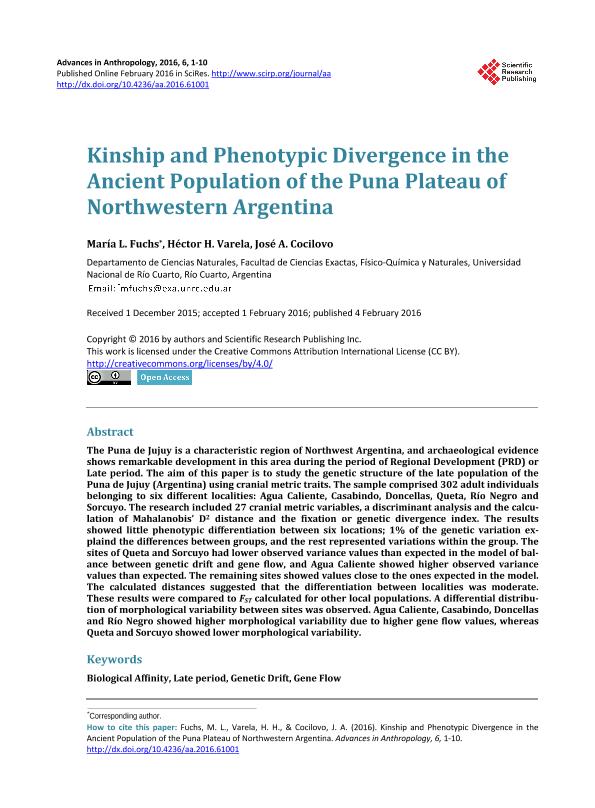Mostrar el registro sencillo del ítem
dc.contributor.author
Fuchs, Maria Laura

dc.contributor.author
Varela, Hector Hugo

dc.contributor.author
Cocilovo, Jose Alberto

dc.date.available
2022-11-30T18:21:18Z
dc.date.issued
2016-02
dc.identifier.citation
Fuchs, Maria Laura; Varela, Hector Hugo; Cocilovo, Jose Alberto; Kinship and Phenotypic Divergence in the Ancient Population of the Puna Plateau of Northwestern Argentina; Scientific Research Publishing; Advances in Anthropology; 6; 2-2016; 1-10
dc.identifier.issn
2163-9361
dc.identifier.uri
http://hdl.handle.net/11336/179616
dc.description.abstract
The Puna de Jujuy is a characteristic region of Northwest Argentina, and archaeological evidence shows remarkable development in this area during the period of Regional Development (PRD) or Late period. The aim of this paper is to study the genetic structure of the late population of the Puna de Jujuy (Argentina) using cranial metric traits. The sample comprised 302 adult individuals belonging to six different localities: Agua Caliente, Casabindo, Doncellas, Queta, Río Negro and Sorcuyo. The research included 27 cranial metric variables, a discriminant analysis and the calculation of Mahalanobis? D2 distance and the fixation or genetic divergence index. The results showed little phenotypic differentiation between six locations; 1% of the genetic variation explains the differences between groups, and the rest represents variations within the group. The sites of Queta and Sorcuyo have lower observed variance values than expected in the model of balance between genetic drift and gene flow, and Agua Caliente showed higher observed variance values than expected. The remaining sites showed values close to the ones expected in the model. The calculated distances suggest that the differentiation between localities is moderate. These results are compared to FST calculated for other local populations. A differential distribution of morphological variability between sites was observed. Agua Caliente, Casabindo, Doncellas and Río Negro showed higher morphological variability due to higher gene flow values, whereas Queta and Sorcuyo showed lower morphological variability.
dc.format
application/pdf
dc.language.iso
eng
dc.publisher
Scientific Research Publishing
dc.rights
info:eu-repo/semantics/openAccess
dc.rights.uri
https://creativecommons.org/licenses/by/2.5/ar/
dc.subject
BIOLOGICAL AFFINITY
dc.subject
LATE PERIOD
dc.subject
GENETIC DRIFT
dc.subject
GENE FLOW
dc.subject.classification
Otras Historia y Arqueología

dc.subject.classification
Historia y Arqueología

dc.subject.classification
HUMANIDADES

dc.title
Kinship and Phenotypic Divergence in the Ancient Population of the Puna Plateau of Northwestern Argentina
dc.type
info:eu-repo/semantics/article
dc.type
info:ar-repo/semantics/artículo
dc.type
info:eu-repo/semantics/publishedVersion
dc.date.updated
2022-11-30T12:04:21Z
dc.journal.volume
6
dc.journal.pagination
1-10
dc.journal.pais
Estados Unidos

dc.description.fil
Fil: Fuchs, Maria Laura. Universidad Nacional de Río Cuarto. Facultad de Ciencias Exactas, Fisicoquímicas y Naturales. Departamento de Ciencias Naturales; Argentina. Consejo Nacional de Investigaciones Científicas y Técnicas. Centro Científico Tecnológico Conicet - Córdoba; Argentina
dc.description.fil
Fil: Varela, Hector Hugo. Universidad Nacional de Río Cuarto. Facultad de Ciencias Exactas, Fisicoquímicas y Naturales. Departamento de Ciencias Naturales; Argentina. Consejo Nacional de Investigaciones Científicas y Técnicas. Centro Científico Tecnológico Conicet - Córdoba; Argentina
dc.description.fil
Fil: Cocilovo, Jose Alberto. Universidad Nacional de Río Cuarto. Facultad de Ciencias Exactas, Fisicoquímicas y Naturales. Departamento de Ciencias Naturales; Argentina. Consejo Nacional de Investigaciones Científicas y Técnicas. Centro Científico Tecnológico Conicet - Córdoba; Argentina
dc.journal.title
Advances in Anthropology
dc.relation.alternativeid
info:eu-repo/semantics/altIdentifier/doi/http://dx.doi.org/10.4236/aa.2016.61001
dc.relation.alternativeid
info:eu-repo/semantics/altIdentifier/url/https://www.scirp.org/journal/paperinformation.aspx?paperid=63319
Archivos asociados
